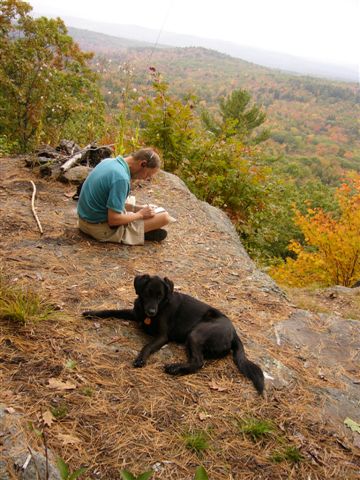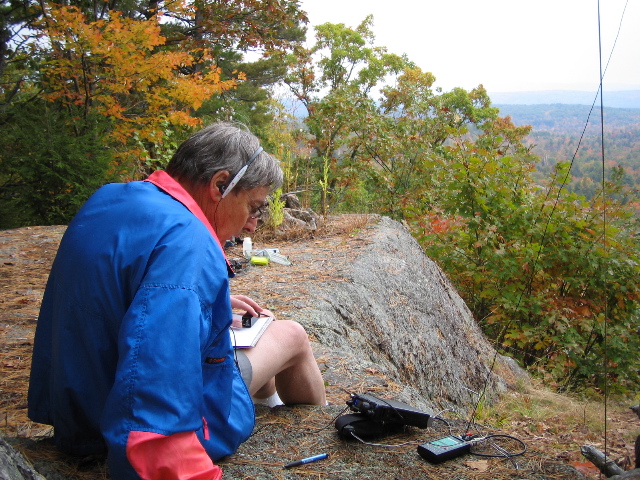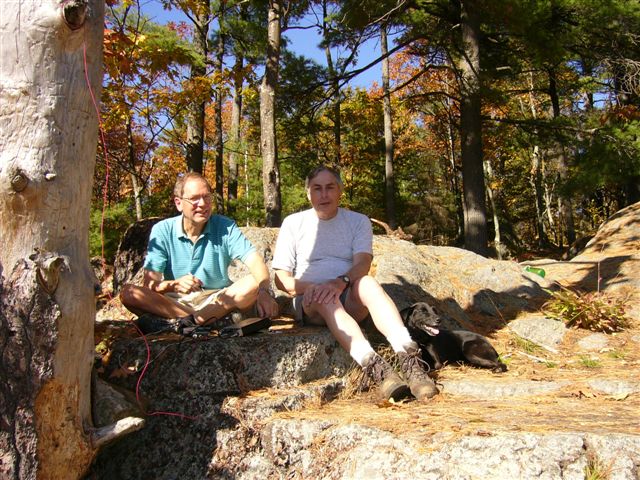Discovering the Ledges
On and off for a couple of years, I've
searched for the "Indian Ledges."
The
cliffs feature 100 foot drops and
superb views.The place is known to
old-timers in Sanbornton, but remained a mystery
to me for more than 40 years. Today Dick, N1LT,
and I discovered the elusive mountain and made
what must be the first transatlantic radio contact
ever from the place.
The ledges are several miles into
the woods from the nearest road. A wrong
turn could leave a hiker in the middle of
nowhere... many times I had followed
a trail only to take a wrong turn in
the maze of old logging roads.

While looking for the peak earlier this week I
met a local logger working in the woods. He
said he'd been there almost 20 years ago, and
he gave me directions. So this afternoon Dick
and I packed our gear and started out with
my dog Meghan.
It was one of those rare October days when the
warmth of summer lingers, and the color and glory
of fall radiates in sheer brilliance. This time, sure of
the route, we set out with relaxed confidence. We
dodged brambles, balanced carefully as we crossed
brooks on ancient logs, and revelled at the sight of
mamouth pine trees towering more than 100 feet high
alongside the trail.
About a mile and a quarter into the woods, we started a very
steep climb and knew our goal was near. Just as we were
both feeling the exercise, we saw the top ahead.
Huge rocks, out-croppings and boulders were everywhere.
Giant trees adorned the cap. Soon we were gazing out
upon a grand expanse of forest and gentle hillsides in fall gold.
We scouted the peak and picked out antenna trees.
I chose an old pine near the edge of the cliffs. I threw a
half-wave wire straight up over a branch. At the most,
it was 15 degrees off vertical. Dick chose a pine farther
away from the cliff. Even though his wire was about the
same length as mine, his sloped at nearly 40 degrees.
The difference between the two antennas was soon
to become critical.

I chose 20 meters and in a minute was chatting with
N4RLD near Atlanta. Rick had an awesome signal,
way over S9. Turns out he was running a kilowatt.
He gave me a 559 and said my 3 watts was
peaking at 579. I was running an ATS-2 with a
ZM-2 tuner.

Dick was having a harder time on 40 meters
with very few strong signals and heavy static from
an approaching thunderstorm. He was running an
FT-817 with the Electraft T-1 tuner. So he switched
to 20 meters and focused on EA6UN who
was calling CQ from the Balaeric Islands.
Jurek could hear Dick's signal, but not well
enough to get his call. So I gave him a try
with my setup. Darned if he didn't answer and
give me a 569 report. The only significant
difference between Dick's setup and mine was
the angle of radiation from the two antennas.
What a difference a few degrees can make.
We spent more than an hour at the peak, and
packed reluctantly for the return hike.
Part 2
This story has a sequel...
Not content to let the last glorious days of fall
slip through our fingers, Dick and I went back up
to the ledges four days after our first visit.
This time it was warmer (over 70 degrees) and the
trees were nearly at peak color. The day was
beyond belief and the bands were far, far better
than they were on our first trip. We spent close
to four hours at the site. Time and again we
stood at the edge and gazed at the remarkable vista.

We set up a single antenna... a 65 foot wire
configured as an L. The antenna went straight
up 30 feet and over about 35 feet. Combined
with the 817 and the T-1 tuner we made some
gang-buster QSOs.
We worked easily into eastern Europe, hitting
Russia, Ukraine, and Hungary. Then we swtiched
to 15 meters and worked into Uruguay with a 559
report from there. Dick and I sat about 15 feet
back from the drop-off and took turns operating.

The sun
fell in the afternoon sky and we gathered our
gear for the return trip. We were both keenly aware that our
days of summer outings and expeditions would soon
be over as well.
-end-




